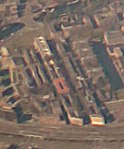Indische Buurt

Indische Buurt ("Indies Neighborhood") is a neighborhood in the borough of Oost, the eastern part of the city of Amsterdam, Netherlands. The name of the neighborhood dates from the early 20th century, and is derived from the fact that the neighborhood's streets are named after islands and other geographical concepts in the former Dutch colony of the Dutch East Indies or now known as Indonesia. The first street was named in 1902. In 2003, the neighborhood had around 23,000 inhabitants. The neighborhood is bounded on the west by the railroad Amsterdam - Hilversum (with the Muiderpoort Station), on the east side by Flevopark, on the north side by Zeeburgerdijk and on the south side by the Ringvaart Watergraafsmeer. Indische Buurt is the oldest part of the former Zeeburg district and is very ethnically diverse. A high percentage of the population is of immigrant origin (for Zeeburg this is already high at 55%, but higher in the Indische Buurt) and there are an estimated 100 languages spoken.
Excerpt from the Wikipedia article Indische Buurt (License: CC BY-SA 3.0, Authors, Images).Indische Buurt
Molukkenstraat, Amsterdam Oost
Geographical coordinates (GPS) Address Nearby Places Show on map
Geographical coordinates (GPS)
| Latitude | Longitude |
|---|---|
| N 52.363833333333 ° | E 4.93955 ° |
Address
Molukkenstraat
Molukkenstraat
1095 AT Amsterdam, Oost
North Holland, Netherlands
Open on Google Maps









